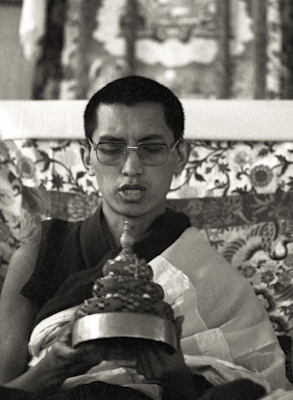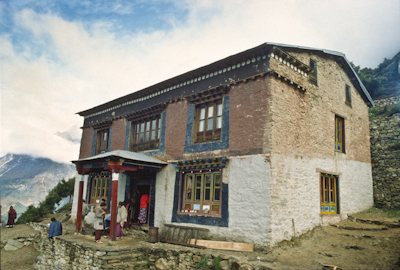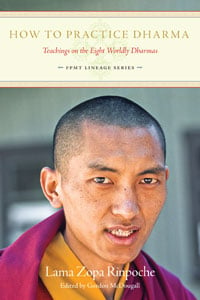Dear LYWA friends and supporters,
Happy New Year! I hope you and your family and friends are well and that this year will be the best ever and see all your Dharma wishes fulfilled. Here at LYWA we feel blessed to be able to dedicate all our energy to working for the enlightenment of all sentient beings and thank you for your help in providing us with the opportunity to do so. We are eternally grateful for your kind and generous support. Thank you.
And speaking of your support, we especially want to thank you for contributing to our 2012 year-end appeal, which saw us exceed our goal. This gets us off to a flying start this year, a year in which we plan to make many more Dharma teachings available, in print, as ebooks and on line. Keep watching this space!
Praise for Our Latest Book, How to Practice Dharma
From a nun in retreat in Australia to our PFL editor Gordon McDougall:
I have brought your superb book of Rinpoche’s teachings on the eight worldly dharmas on a three-week holiday/semi-retreat in Tasmania (just to put you in the picture)! Fantastic! The best book I could ever have chosen.
It has changed the whole way I live my life, probably the most relevant, meaningful book I have read.
Thank you from my heart for your long, long hours spent in producing such a superb collection of Rinpoche’s teachings on the one topic. Could I say that this seems a brilliant way of presenting Rinpoche’s unique way of teaching; one subject: no escape! And for thick-skins like me, it seems the only “doable” way of showing the ways we pretend to practice Dharma with How to Practice Dharma.
It has really excited me, reading this book; I find I’m often in pursuit of what I’m thinking, or about to say, wondering which of the eight is doing what! Even writing this...
Re-reading your preface, it looks like you have expressed exactly how I feel, that we really need to hear about the eight worldly dharmas and that Rinpoche never tires, never gives us up... How painful to understand that by following the eight, so much of my precious time has been wasted! But to have already in my hand, the remedy, and not so very difficult.
I send you my deep appreciation Gordon, for presenting Rinpoche’s teachings so impeccably, and making them accessible to many, many students in all traditions. This is one who has benefited in a very meaningful way!
You can order the book on our website or purchase it from one of the many ebook vendors who carry our books; see our online store for details.
More on How to Practice Dharma
We were delighted to learn that Vajrapani Institute is running a course based on Rinpoche’s teachings on the eight worldly dharmas. We encourage other centers to do the same.
I recently led a couple sessions based on the book at Kurukulla Center, too, and it worked well.
If you would like to do the same at your center, please let us know. We will make copies of the book available to you at 50% off the already low retail price of $10.
What's New On Our Website We recently posted teachings from a booklet titled How to Offer a Mandala. Compiled and edited by Ven. Thubten Wongmo and Ven. Sangye Khadro, this precious booklet includes teachings from Lama Zopa Rinpoche at Kopan Monastery, Tushita Meditation Centre and Bodhgaya in the 1970s and ’80s, with additional material from other high lamas. It includes specific instructions on the actual practice supplemented with drawings and diagrams.
We recently posted teachings from a booklet titled How to Offer a Mandala. Compiled and edited by Ven. Thubten Wongmo and Ven. Sangye Khadro, this precious booklet includes teachings from Lama Zopa Rinpoche at Kopan Monastery, Tushita Meditation Centre and Bodhgaya in the 1970s and ’80s, with additional material from other high lamas. It includes specific instructions on the actual practice supplemented with drawings and diagrams.
We have also just posted Geshe Lama Konchog's Commentary on the Seven-Point Mind Training, given at Atisha Centre, Bendigo, Australia, from October 31 to November 3, 1987. This teaching is now posted on our companion website TeachingsFromTibet.com.
And, we have just added selections from the classic book Wisdom Energy 2, a compilation published by Publications for Wisdom Culture in England in 1979. These include a teaching from Lama Zopa Rinpoche on "Seeking the I", drawn from teachings given at Lawudo Monastery and Instituto Lama Tzong Khapa; a teaching from Lama Yeshe on "True Renunciation" given at Nagarjuna Institute in Spain; Lama answering a question about mantras at Kopan; and a teaching from Lama on non-duality, which is this month's eletter teaching below.
Listen online to excerpted teachings from the 29th Kopan Lamrim Course in 1996. In these teachings Rinpoche discusses patience and bodhicitta, and gives a lengthy talk on reincarnation, which includes Q&As with students.
Help Spread the Dharma
People often write asking how they can help us in ways other than giving money. So, if you would like to do something, here’s a suggestion: write reviews of our books on sites such as Amazon.com and eBay. See an example of a review on Amazon.com. Anyone can contribute!
You can also help us by "liking" us on various social media sites. And, if you have a website, placing links to lamayeshe.com also increases our visibility and search rankings. See our Volunteer Opportunities page for more details.
Lawudo Retreat Centre The monastery and retreat center built around the cave of the Lawudo Lama, Lama Zopa Rinpoche’s previous life (well, Rinpoche is still the Lawudo Lama!) is a fantastic place to visit and to do retreat. Visit their website and check them out on FaceBook.
The monastery and retreat center built around the cave of the Lawudo Lama, Lama Zopa Rinpoche’s previous life (well, Rinpoche is still the Lawudo Lama!) is a fantastic place to visit and to do retreat. Visit their website and check them out on FaceBook.
You can see some great early Lawudo photos like the one shown here in the LYWA Image Gallery. Just type “Lawudo” into the gallery search field and be sure to click the button to show all search results.
I am mentioning this so that you might consider supporting the Lawudo Gompa Project, which, as you may know, is headed up by Rinpoche’s brother Sangay Sherpa! And of course, the longtime keeper of the Lawudo Gompa is Rinpoche’s sister, Anila Ngawang Samten.
Lawudo is an amazing place and I recommend you try to go there at least once in your life. I was there a few times in the ’70s and the four-and-a-half months I spent in Vajrasattva retreat there were probably the best months of my life!
Singapore and Malaysia
I'll be in Singapore from February 20th to March 13th with a side trip to KL March 1-5. I'd be happy to get together with anyone who'd like to meet me. Please let me know.
As mentioned above, this month we leave you with a teaching by Lama Yeshe, which, although previously-published many years ago, you may not have seen before.
Thank you again for your generous support, especially if you contributed to our 2012 year-end appeal. (By the way, please let us know if you need an annual receipt summarizing your 2012 donations and haven't received one yet.) We really are so grateful to you.
Much love, 
Nick Ribush
Director
This Month's Teaching: Non-Duality
 During the summer of 1977, Lama Yeshe visited Madison, Wisconsin and stayed at the home and center of his teacher, Geshe Lhundup Sopa. While there he gave six weeks of teachings on Maitreya’s Discriminating between Relative and Ultimate Reality (Dharma-dharmata-vibhanga-karika) from which the following is a brief extract.
During the summer of 1977, Lama Yeshe visited Madison, Wisconsin and stayed at the home and center of his teacher, Geshe Lhundup Sopa. While there he gave six weeks of teachings on Maitreya’s Discriminating between Relative and Ultimate Reality (Dharma-dharmata-vibhanga-karika) from which the following is a brief extract.
Maitreya’s root text is a dynamic, meditative approach to the profound view of reality, emphasizing the non-dual nature of all existence. In the following selection, Lama Yeshe comments on some central ideas from this text and offers an introduction to non-dualistic thought.
There is no purpose or value in studying this subject merely for intellectual stimulation. That would be a complete waste of time. The knowledge contained in Lord Maitreya’s teaching is incredibly deep but only worthwhile if pursued with the proper motivation. Unless we engage in this study for the purpose of eradicating our psychological problems, we would probably do better to spend out time trying to make Coca-Cola; at least then we could quench our thirst.
We have all probably heard a lot of gossip about mahamudra meditation. “Maha” means great and “mudra” means seal. If I have a government seal no one impedes or harasses me. When I have an official government seal I am free to go wherever I choose. The seal of mahamudra is similar, but here we are talking about a state of mind that is beyond our ordinary dualistic view of existence. This is the great seal that sets us free from the prison of samsara. Mahamudra itself is non-duality. It is the absolute true nature of all universal phenomena, be they internal or external.
What is meant by the term “non-duality”? All existing phenomena, whether deemed good or bad, are by nature beyond duality, beyond our false discriminations. Nothing that exists does so outside of non-duality. In other words, every existing energy is born within non-duality, functions within non-duality, and finally disappears into the nature of non-duality. We are born on this earth, live our lives and pass away all within the space of non-duality. This is the simple and natural truth, not some philosophy fabricated by Maitreya Buddha. We are talking about objective facts and the fundamental nature of reality, neither more nor less.
If we are to achieve the realization of mahamudra it is essential to develop skill in the art of meditation. But to meditate properly we must first listen carefully to a faultless exposition of the subject matter. This will give us an accurate and precise understanding of the aim of meditation. If we have a clear intention of putting such explanations into practice in meditation, then merely to hear the teachings becomes a powerful experience instead of some kind of superficial intellectual “trip.”
To understand that the dualistic mind, lost in false discriminations, is the source of beginningless and endless suffering for oneself and others is to have a truly valuable insight that will profoundly change the quality of our daily lives.
The dualistic mind is, by nature, contradictory. It sets up an internal dialogue that has forever disturbed our peace. We are always thinking, “Maybe this, maybe that, maybe something else”—and so on. Dualistic thinking perpetuates a conflict within our mind. It causes us to be agitated and deeply confused. When we know that this confusion is the result of a mind conditioned by the dualistic view of reality, we can do something about it. Until then it will be impossible for us to come to grips with the problem because we have not correctly identified its true cause. It is not enough merely to treat symptoms. It is clear that we must completely eradicate the source of problems if we are to become truly problem-free.
As our understanding and knowledge of mahamudra deepens we shall come to realize that the way things appear to us is simply a projection of our mind. For example, it is not a question of whether Madison, Wisconsin exists or not, but whether the way in which we perceive Madison exists in reality or not. It should be clear that this is not the same as the nihilistic assertion that nothing exists. We are simply seeking the correct view of reality.
To clarify this point further we can investigate the fantasies we project upon our friends and the people we live with or meet every day. Our dualistic mind superimposes an attractive or repellent mask upon the presented image of everyone we meet, with the result that reactions of desire and aversion arise which color our attitudes and our behavior towards this person. We begin to discriminate: “He is good,” or “She is bad.” Such rigid, preconceived attitudes make it impossible to communicate properly with even our close friends, much less with the profound wisdom of an enlightened being, or buddha.
If we persistently investigate the inner workings of the mind, we shall eventually be able to break through our habitual overconcretized mode of perceiving the universe and let some space and light into our consciousness. In time we shall have an insight into what non-duality actually is. At that time we should simply meditate without intellect or discursive thought. With strong determination we should merely let the mind meditate single-pointedly on the vision of non-duality, beyond subject/object, good/bad, and so on. The vision of non-duality can be so vivid and powerful that we feel we can almost reach out and touch it. It is very important simply to mingle the mind with this new experience of joy and luminosity without seeking it by analysis. We must realize directly that non-duality is the universal truth of reality.
In directing our mind along the path of Dharma it is best not to expect too much too quickly. The path is a gradual process to be negotiated step by step. Before one can follow practices that bring a quick and profound result there are preparatory practices that must be done. Lama Tsongkhapa, for example, strove very hard for the realization of shunyata, or emptiness, but met with no success, in spite of being a renowned teacher with many disciples. Finally Manjushri, the embodiment of perfect wisdom, revealed to him that he must make a retreat in order to purify his mind-stream completely of all gross and subtle delusions, as well as their imprints. Tsongkhapa then withdrew to a cave, where he did three and a half million prostrations as well as innumerable mandala offerings and other preliminary purification practices. As his thought-stream became purified, his understanding of emptiness began to deepen. This transformation continued until he reached full awakening.
It is helpful if we understand the realization of non-duality has many levels or degrees. From the philosophical point of view there are two Indian schools of Mahayana Buddhist thought: the Cittamatra or Mind Only school and the Madhyamaka or Middle Way school with its Prasangika or Consequentialist subdivision. Both of these schools agree that the dualistic view is deceptive and therefore not ultimately true, and both assert that non-duality is the absolute nature of all things and is ultimately true. Though the Mind Only and Consequentialist schools agree on these points, their understanding of what is meant by non-duality varies somewhat.
From the Consequentialist point of view the Mind Only doctrine presents a helpful approach to conventional truth but does not accurately describe the absolute true nature of reality. In other words, they state that the Mind Only view of reality is still tainted by superstitious beliefs. Despite this, even the Consequentialists agree that if we are able to realize the Mind Only view we are qualified to practice the profound methods of tantric yoga and reach unimaginably high levels of understanding.
What we should know is that the Mind Only school contends that all objects of the sense world are simply manifestations of mental energy and do not exist externally at all. According to the Consequentialists it is more correct to say that the existence of all things depends upon recognition by an imputing consciousness. Both schools attach great importance to the mind’s role in determining the way in which entities arise, but the higher Consequentialist school says that to assert that there are no external phenomena whatsoever—that there is nothing other than mind—is an error. Such a view deviates from the true middle path that transcends all extremes.
The Mind Only meditators destroy the dualistic view by seeing that all objects in the field of the six senses are no more than mere projections of our mind itself. All relative phenomena arise and disappear like the bubbles in a glass of Coca-Cola. In this analogy, Coca-Cola corresponds to the mind itself while the bubbles arising within it are all relative phenomena perceived by the six senses. Can the bubbles in the Coca-Cola be separated from the Coca-Cola? No. Therefore, as they are not separate, they are non-dualistic. When a deep understanding of this pervades our consciousness, the foundations of samsara are shaken.
The Consequentialists transcend dualism by realizing that both subject: mind, and object: the sense field, are illusory and empty of self-existence. Subject and object are mutually interdependent: they cannot exist independently of one another. For this reason the Consequentialists do not agree with the Mind Only position that mind itself—as the source and substance out of which all relative phenomena arise—has true, inherent self-existence. According to the Consequentialists, all phenomena, including mind, are empty of even the slightest trace of self-existence.
The fully awakened Lama Tsongkhapa, in his work The Heart of Perfection, explained that first we must master the Mind Only view because from that elevated position we can easily progress to the highest, most sublime view, that of the Consequentialists. It is for this very reason that Maitreya Buddha explained the Mind Only doctrine. It is the bridge we rely upon to cross over from a completely materialistic outlook to the transcendental view of reality which is beyond all extremes.
When I expound subjects of this kind, I try to avoid being too philosophical—dwelling on “Mind Only says this,” “Consequentialists assert that”—especially when we are dealing with such subtle and penetrating texts as this one. Generally speaking, this teaching by Maitreya Buddha is considered to be a Mind Only text; however, it is not necessarily confined to a Mind Only interpretation. This entire text also lends itself perfectly to a Consequentialist explanation of reality and the two levels of truth. It is essential to know these two levels of truth well because when we successfully reconcile them we arrive at a true understanding of things as they actually are, and become free of suffering and its cause.
I would like to go over this point once more. Each phenomenon has two characteristic qualities or natures. One is its relative appearance: its color, shape, quality, texture, and so forth. This is termed “deceptive truth” because it appears to exist independently of causes and conditions. In terms of this level of truth we discriminate subject and object, this and that, and so on. Even though all phenomena, internal and external, partake of this relative nature, they nevertheless arise, exist and pass away without ever departing from the sphere of non-duality. The second level of truth is the non-dualistic, absolute, true nature of things, which spontaneously co-exists with all phenomena.
Phenomena themselves and the absolute nature of phenomena, have distinctive qualities; they are not the same thing. All phenomena simultaneously possess a relative or conventional mode of existence as well as an absolute, true nature, which is non-dualistic. Certain energies come together and produce a relative phenomenon. Its relative mode of existence is dualistic, and appears in terms of a subject and object relationship; yet all things arise within the space of non-duality.
Relative phenomena (dharma) are like bubbles. They are the dualistic vision of the dualistic mind. Therefore, they are not truly existent or real. Absolute, true nature (dharmata) is non-dualistic. It is, therefore, real or true. Though relative phenomena and the dualistic vision do exist and function, they are not ultimately true. That is the point.
When we say that all relative phenomena have the nature of non-duality we are not saying that all existence is emptiness or absolute truth. All relative existence is not absolute truth. Relative phenomena are not absolute phenomena. But every existing energy, whether relative or absolute, has the characteristic nature of non-duality.
I want to explain this further. When we contemplate non-duality the dualistic vision should disappear. Therefore we can say that non-duality is absolute nature. But can we say that all non-duality is absolute nature? No. Why not? Because, although all phenomena partake of the nature of non-duality, we do not have to perceive non-duality itself in order to perceive conventional reality. My head, for example, has the nature of non-duality, and yet we cannot say my head is absolute truth of emptiness. In order to apprehend my head you do not need to apprehend non-duality. Yet a doubt may persist: “If my head has the characteristic nature of non-duality why then, when you apprehend my head, do you not apprehend non-duality itself?” Because there is the veil of dualistic mind between you and my head.
It may become clearer with another example. Which is the more pervasive, the population of the United States, or the population of Madison, Wisconsin? The population of the United States includes the population of Madison, but the inhabitants of Madison do not pervade the population of the entire United States. Non-duality is like the population of the United States, and all relative phenomena are like the inhabitants of Madison. All relative phenomena are embraced by non-duality, because they arise within the space of non-duality; all relative phenomena demonstrate non-duality.
To conclude, in order to understand non-duality we have to understand emptiness. We can say therefore that non-duality is emptiness. But all the bubbles of relative phenomena, though they themselves are ultimately non-dual, are not emptiness. Relative and absolute truth do not pervade each other, but both are pervaded by non-duality. If we can understand the distinctive characteristics as well as the non-contradictory natures of these two levels of truth, we can gain freedom from even the subtlest delusions of mind. There can be no stronger motive for study and meditation than this.
Edited by Chris Kolb. First published in Wisdom Energy 2, Publications for Wisdom Culture, Ulverston, England, 1979.
































